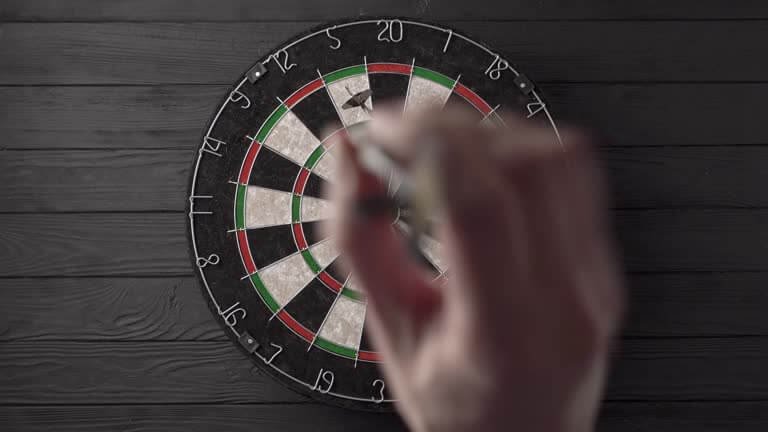Darts is a sport that demands precision, strategy, and mental fortitude. Whether you’re playing casually with friends or competing in a league, the key to improvement lies in understanding your performance and making data-driven decisions. Analyzing your darts game is an essential step toward becoming a better player. This article will guide you through various aspects of game analysis, helping you identify areas for improvement and develop a more effective practice routine.
1. Why Analyze Your Game?
1. Identify Strengths and Weaknesses
The first step in improving your darts game is understanding your current skill level. Analysis helps you pinpoint your strengths, such as which segments of the board you hit most often, and your weaknesses, like areas where you consistently miss. This knowledge allows you to tailor your practice sessions to focus on specific aspects that need improvement.
2. Track Progress Over Time
Regularly analyzing your game enables you to track your progress over time. By maintaining a record of your scores, averages, and checkout success rates, you can see how your performance evolves. This information can be motivating and help you stay committed to your practice routine.
3. Adapt to Different Opponents
In competitive play, each opponent presents unique challenges. Analyzing your game allows you to adapt your strategies based on the playing styles and strengths of your competitors. This flexibility can be the difference between winning and losing.
4. Enhance Mental Game
Darts is as much a mental game as it is physical. Understanding your tendencies under pressure—such as how you react after a missed shot—can help you develop mental strategies to stay focused and calm during matches.

2. How to Analyze Your Darts Game
1. Record Your Performance
The first step in analysis is to keep track of your performance during practice and matches. This could be as simple as noting down scores or as complex as using software designed for darts statistics. Here are some key metrics to consider:
- Scores: Record your scores in practice sessions and matches. Note your average score per turn and identify any trends.
- Hit Rates: Track how often you hit your target segments, such as the bullseye, treble 20, and specific checkouts.
- Checkout Success Rate: Record how often you finish a game, noting which checkouts you hit successfully and which ones are problematic.
- Missed Darts: Document where you miss—whether it’s high, low, left, or right. This information will help you adjust your aiming and throwing technique.
2. Use Technology
In the digital age, there are various tools and apps available to help you analyze your darts game more efficiently:
- Darts Scoring Apps: Many mobile applications allow you to track your scores, calculate averages, and analyze performance trends over time.
- Video Analysis: Recording your throwing technique can provide valuable insights. Watch your throws to identify inconsistencies in your stance, grip, or follow-through.
- Statistical Software: Some players use advanced statistical software to analyze their performance in-depth, tracking metrics like shot efficiency and game outcomes against various opponents.
3. Review Match Footage
If you have the opportunity, reviewing footage of your matches can be incredibly enlightening. Watching yourself play allows you to:
- Identify Patterns: Notice how you perform under pressure and identify any patterns in your throwing technique.
- Analyze Opponent Interaction: Understand how you react to your opponent’s scoring and strategies. This knowledge can help you adapt your gameplay in future matches.
- Emotional Responses: Pay attention to your mental state throughout the match. Identify moments of frustration or confidence, and think about how they affected your performance.
4. Seek Feedback
Sometimes, an outside perspective can offer invaluable insights. Consider the following:
- Practice Partners: Ask for feedback from fellow players. They may notice aspects of your game that you overlook.
- Coaches or Mentors: If possible, work with a coach who can provide professional guidance tailored to your specific needs.
- Online Forums: Participate in darts communities, where you can share experiences and seek advice from more experienced players.

3. Setting Goals Based on Analysis
Once you’ve gathered and analyzed data about your performance, it’s essential to set goals to improve. Here’s how to do it effectively:
1. Specificity
Make your goals specific. Instead of saying, “I want to get better at darts,” try something like, “I want to increase my average score from 60 to 70 over the next month.”
2. Measurable Objectives
Your goals should be measurable. This could involve tracking your scoring averages, checkout success rates, or the number of times you hit your target segments.
3. Achievable Targets
Set realistic goals based on your current skill level and available practice time. For example, if you’re currently averaging 50, aiming for 80 within a month may be unrealistic. Instead, aim for a gradual increase.
4. Time-Bound Goals
Establish a timeline for achieving your goals. Setting deadlines helps create a sense of urgency and keeps you motivated.
4. Effective Practice Routines
With your analysis in hand, you can create tailored practice routines to address your weaknesses:
1. Focused Drills
Based on your analysis, design practice sessions that target your specific weaknesses. For example:
- Treble 20 Practice: If you struggle with hitting treble 20, dedicate a session to only aiming at that segment.
- Checkout Challenges: Spend time practicing specific checkouts that you often miss in matches.
2. Game Simulation
Incorporate game-like scenarios into your practice sessions. This could include playing against a friend or simulating match conditions to develop your skills under pressure.
3. Review Progress Regularly
Periodically reassess your performance data and adjust your practice routines accordingly. If you see improvement in one area, shift your focus to another aspect of your game.
5. Conclusion
Analyzing your darts game is not just a task; it’s a pathway to continuous improvement. By recording your performance, using technology, seeking feedback, and setting measurable goals, you can gain valuable insights into your gameplay and enhance your skills. Remember, improvement in darts, as in any sport, takes time and consistent effort.
Whether you’re a casual player or a competitive dart enthusiast, embracing the analytical side of the game can unlock your potential and elevate your performance. So grab your darts, start analyzing, and watch your game reach new heights!





